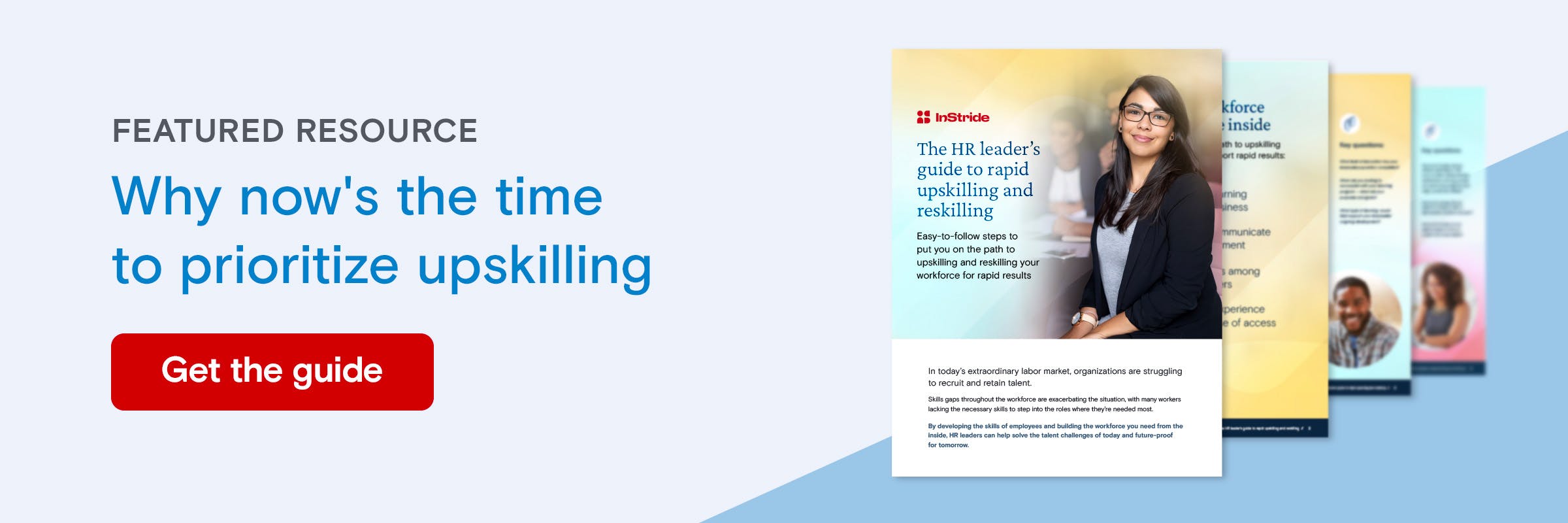Employee training and education deliver a range of benefits, both to the individual as well as the business overall. But it’s unrealistic to expect that all employees can take on learning in their spare time and maintain adequate performance at work. Unlike most traditional students, adult learners have to juggle learning with full-time work and likely have more extensive personal responsibilities such as child care. Despite this, today’s employees still seek out learning opportunities at work.
Employers can ease some of these challenges by exploring approaches to corporate learning that are flexible and accommodating to a range of schedules and responsibilities.
That’s the idea behind “learning in the flow of work” — an emerging concept that’s gaining popularity among HR professionals who are finding ways to make workplace learning more accessible.
What is learning in the flow of work?
Coined by Josh Bersin, learning in the flow of work is a mode of delivering learning to employees as part of their daily work.
The idea is to provide useful and relevant learning experiences that help employees build skills without disrupting employees’ existing workflows. In practice, this could look like a variety of different things. One example of learning in the flow of work is asking employees to share recent wins or mistakes and what they learned from them. This encourages knowledge-sharing and provides a way for employees to apply these learnings in real-time.
Another example might include implementing microlearning to help employees brush up on product updates. For instance, let’s say a clothing retailer is getting ready to launch a new line. To get their Sales Associates up-to-speed, this company rolls out a series of short training videos that get delivered to the employees right after they clock in the days leading up to the launch.

What are the benefits of learning in the flow of work?
When implemented effectively, learning in the flow of work is beneficial for both employees and businesses.
Benefits for employees include:
- Employees don’t need to change their habits to participate in learning. Learning content is presented when it’s most useful and employees are the most motivated to learn.
- Newly-learned skills can be applied immediately.
- Employees can avoid some of the decision paralysis that comes with on-the-job learning. Rather than having to choose between a host of different training courses on their own, the learning that they need is delivered to them.
Benefits for businesses include:
- Employees who experience growth and advancement as a daily part of their job can be significantly more engaged at work. A study conducted by Bersin found that employees who spend time at work learning are 47% less likely to be stressed, 39% more likely to feel successful, 23% more ready to take on additional responsibilities, and 21% more likely to feel confident and happy. This, in turn, boosts performance and even retention.
- Faster time-to-productivity rate as the need for dedicated, separate training sessions decreases. Instead, employees are learning while completing their daily work and can apply what they learn right away.
How to decide if learning in the flow of work is right for your company
Now that you’re familiar with the benefits of learning in the flow of work, it’s easy to see how implementing it can be well worth the time and effort. However, it’s important to remember that this practice likely can’t address all of your organization’s learning needs.
Certain roles will still require employees to hold degrees or other credentials that require formal learning, such as access to debt-free education. Additionally, some skills can only be developed through other initiatives such as mentorship programs and on-the-job training. These other types of learning programs can act as a powerful supplement to learning in the flow of work.
What to know before implementing learning in the flow of work
If you’re thinking about implementing learning in the flow of work at your organization, here are some things to keep in mind:
- Technology: You need the right technology in place to be able to give employees access to relevant learning resources when they need them. Learning content is typically administered through a learning management system (LMS), but can also be delivered through knowledge bases or learning experience platforms (LXPs). It’s also important to implement analytics or reporting so that you can measure the impact of learning in the flow of work on business objectives.
- User adoption: As with any process, tool or strategy that you roll out, you will also need to promote awareness of this new approach and teach your employees how to adopt learning in the flow of work. It’s helpful to point out that this approach can benefit employees by streamlining their workflows and promoting skills development.
- Content: To ensure that your learning content is relevant to your employees’ professional and personal development, it’s important to have a clear strategy for how to curate the right content for your business’ unique skills needs. This can often come with a large time commitment since content becomes outdated quickly. That’s something to keep in mind as you’re evaluating whether you have the resources to adopt learning in the flow of work.
- Integration: Don’t forget to consider where learning in the flow of work fits alongside your other L&D initiatives and to determine which skills to target with this format and what the use cases are for other types of learning.
What skills are best suited for learning in the flow of work?
Most teachable skills can be developed in some way via learning in the flow of work. The exception is medical procedures and other high-stakes or credential-dependent responsibilities, which must be learned and integrated via hyper-specific processes to ensure safety and compliance.
Consider making a comprehensive list of all critical skills and competencies within your company, including any associated restrictions and required credentials, and think about which skills are well suited for learning in the flow of work adoption.
An accessible approach to workplace learning
Learning in the flow of work can be an integral and pragmatic element of your larger learning and development strategy. With the right adoption in place, your business can wield this approach to promote learning in the workplace and advance both employee and business goals and growth.
Discover more L&D resources: When it comes to employee learning, accessibility is key. Download this resource for tips on how to address common barriers to learning and ensure your L&D programs are accessible.

